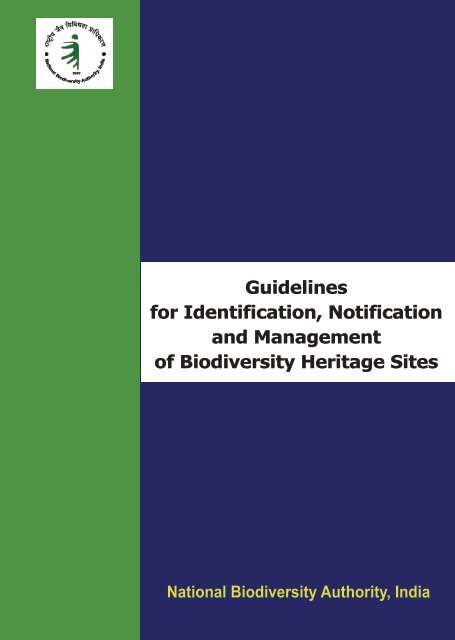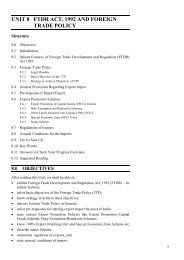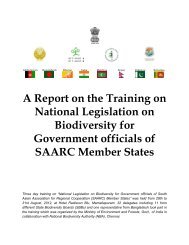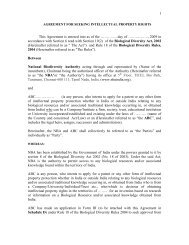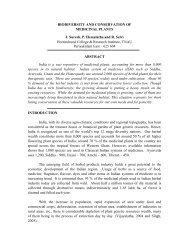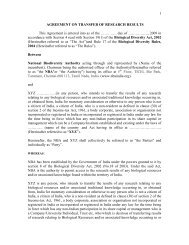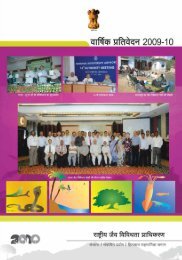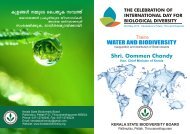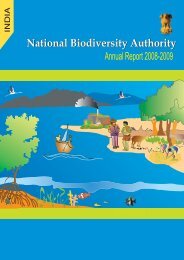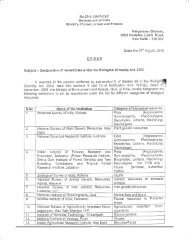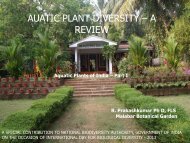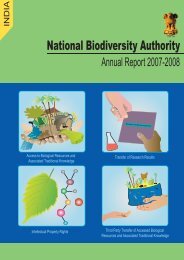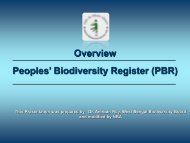Biodiversity Heritage Sites - National Biodiversity Authority
Biodiversity Heritage Sites - National Biodiversity Authority
Biodiversity Heritage Sites - National Biodiversity Authority
- No tags were found...
You also want an ePaper? Increase the reach of your titles
YUMPU automatically turns print PDFs into web optimized ePapers that Google loves.
The Guidelines for Identification, Notification and Management of <strong>Biodiversity</strong> <strong>Heritage</strong><strong>Sites</strong> are printed with the support of UNDP under the INDIA UNDP <strong>Biodiversity</strong> Project onStrengthening Institutional Structures to implement the Biological Diversity Act.Disclaimer: These guidelines available in the NBA website as a soft copy are printed afterediting, for wider circulation in the form of hard copy.For further information<strong>National</strong> <strong>Biodiversity</strong> <strong>Authority</strong>th5 Floor, TICEL Biopark, CSIR Road, Taramani,Chennai – 600 113, Tamil Nadu, INDIAravishankar.thupalli@undp.orgprojectmanager@nbaindia.inwww.nbaindia.org
ForewordSection 37 of Biological Diversity Act 2002 requires notification of areas of biodiversityimportance as <strong>Biodiversity</strong> <strong>Heritage</strong> <strong>Sites</strong>. Keeping in line with this, the <strong>National</strong><strong>Biodiversity</strong> <strong>Authority</strong> undertook an exercise to develop the “Guidelines for selection andmanagement of the <strong>Biodiversity</strong> <strong>Heritage</strong> <strong>Sites</strong>” through an expert committee headed byMr. R. P. S. Katwal and subsequently by Mr. K. Subramanian.I thank the Chairman and Members of the above committees for developing theseguidelines. At present the guidelines are available on the website of <strong>National</strong> <strong>Biodiversity</strong><strong>Authority</strong>. State <strong>Biodiversity</strong> Boards are actively considering designation of <strong>Biodiversity</strong><strong>Heritage</strong> <strong>Sites</strong> using these guidelines.The present booklet on “Guidelines for identification, notification and management of<strong>Biodiversity</strong> <strong>Heritage</strong> <strong>Sites</strong>” is printed under the GOI UNDP project on “StrengtheningInstitutional Structures to implement the Biological Diversity Act” based on the aforesaidguidelines. I thank the Project supported by UNDP for bringing out this important booklet.Dr. Balakrishna PisupatiChairman<strong>National</strong> <strong>Biodiversity</strong> <strong>Authority</strong>Chennai
Guidelines for Identification, Notification andManagement of <strong>Biodiversity</strong> <strong>Heritage</strong> <strong>Sites</strong>1. Introduction1.1. <strong>Biodiversity</strong> is closely linked toecological security and therefore,h u m a n w e l f a r e . I n c r e a s i n gconcerns about dwindling biologicalr e s o u r c e s a n d f e a r s o fmisappropriation led to thecountries around the world adoptedthe Convention on BiologicalDiversity (CBD) in 1992. ThisConvention for the first time,recognized sovereign rights of thenations over their biologicalresources and emphasized thataccess to genetic resources shouldbe only for environmentally soundpurposes and should be subject tonational legislations. India is one ofthe mega biodiversity countries andis also the signatory to the CBD.Taking cognizance of the provisionsof the CBD, and to deal with themanagement of country's biologicalresources, Government of India hasenacted the Biological Diversity Act,2002 (BDA). The BiologicalDiversity Rules were notified in2004.1.2. The Biological Diversity Act providesfor and to deal with the challenges ofconservation of biological diversity,sustainable use of its componentsand fair and equitable sharing ofbenefits arising out of the use ofb i o l o g i c a l r e s o u r c e s a n dknowledge. The BD Act is currentlybeing implemented through adecentralized approach with the<strong>National</strong> <strong>Biodiversity</strong> <strong>Authority</strong>(NBA), State <strong>Biodiversity</strong> Boards( S B B s ) a n d B i o d i v e r s i t yManagement Committees (BMCs)functioning at <strong>National</strong>, State andLocal levels.1.3. Under the BD Act there areprovisions for conservation underin situ and ex situ conditions. As perthe Act, ex situ conservation meansthe conservation of components ofbiological diversity outside theirnatural habitats and in situc o n s e r v a t i o n m e a n s t h econservation of ecosystems andn a t u r a l h a b i t a t s a n d t h emaintenance and recovery of viablepopulations of species in theirnatural surroundings and in the caseof domesticated or cultivatedspecies, in the surroundings wherethey have developed their distinctiveproperties.2. Significance and objectives of<strong>Biodiversity</strong> <strong>Heritage</strong> <strong>Sites</strong>2.1. To strengthen the biodiversityconservation in traditionallymanaged areas and to stem therapid loss of biodiversity inintensively managed areas, there isa need for identification of theseareas of significance. These areasalso represent a positive interfacebetween nature, culture, society,and technologies, such that both
conservation and livelihoodsecurity can be achieved, andpositive links between wild anddomesticated biodiversity areenhanced.2.2. To have a BHS in and around acommunity should be a matter ofpride and honour to that communityand this virtuous act of communitymay work as an example to theentire nation apart from ensuringavailability of the resources to theirown future generation. The areas /sites that are like existing sacredgroves in general and those existingin Eastern Ghats and in North EastIndia and Western Ghats inparticular can be straight away bedeclared and notified as BHS2.3. Under Section 37 of BD Act 2002,t h e S t a t e G o v e r n m e n t i nconsultation with local bodies maynotify in the official gazette, areas ofb i o d i v e r s i t y i m p o r t a n c e a s<strong>Biodiversity</strong> <strong>Heritage</strong> <strong>Sites</strong> (BHS).2.4. Under sub section (2) of Section 37,t h e S t a t e G o v e r n m e n t i nconsultation with the CentralGovernment may frame rules for themanagement and conservation ofBHS.2.5. Under sub section (3) of Section 37,the State Governments shall frameschemes for compensating orsection of people economicallyaffected by such notification.2.6. As per the above mentionedsections of the BD Act, there is anurgent need to under take theactivities mentioned in 2.1. It isalso necessary to instill andnurture conservation ethics in allsections of the society. The creationof BHS will ensure bringing homethese values in the society andthereby put an end to overexploitationof natural resources andavoid environmental degradation.2.7. The creation of <strong>Biodiversity</strong> <strong>Heritage</strong>Site (BHS) may not put anyrestriction on the prevailingpractices of and usages by the localcommunities, other than thosevoluntarily decided by them. Thepurpose is to enhance the quality oflife of the local communities throughthis conservation measure.3. Context and Definitions3.1. <strong>Biodiversity</strong> <strong>Heritage</strong> <strong>Sites</strong> (BHSs)are well defined areas that areunique, ecologically fragileecosystems. They are spread overterrestrial, coastal and inland andmarine waters having richbiodiversity. The BHSs areendowed with richness of wildas well as domesticated species orintra-specific categories, highendemism, presence of rare andthreatened species, keystonespecies, species of evolutionarysignificance, wild relatives /ancestors of domestic / cultivatedspecies or their varieties. Theseareas are also represented by fossilbeds and having significant cultural,ethical or aesthetic values and areimportant for the maintenance
of cultural diversity, with or without along history of human associationwith them.3.2. To effectively conserve and managet h e B H S , “ G u i d e l i n e s f o ridentification, notification andmanagement of the BHS” aredeveloped and issued by NBA.4. The criteria for identification andnotification of BHS4.1 The BHS may be identified andnotified as per the provisions of theSection 37 of the BiologicalDiversity Act. Accordingly areashaving any of the followingcharacteristics may qualify foridentification and notification asBHS.Nallur, Karnataka4.2 Areas that contain a mosaic ofnatural, semi-natural, and manmade habitats, which togethercontain a significant diversity of lifeforms.4.3 Areas that contain significantcomponents of domesticatedbiodiversity component and /orrepresentative agro-ecosystemswith ongoing agricultural practicesthat sustain this diversity.4.4 Areas including very small onesthat offer refuge or corridors forthreatened and endemic fauna andflora, such as community conservedareas or urban greens and wetlands.4.5 All kinds of legal land uses whethergovernment, community or privateand could be considered under theabove categories.4.6 As far as possible those sites whichare not covered under ProtectedArea network under the WildlifeProtection Act 1972 as amendedmay be considered.4.7 Areas that provide habitats, aquaticor terrestrial, for seasonal migrantspecies for feeding and breeding.4.8 Areas that are maintained aspreservation plots by the researchwing of Forest department.4.9 Medicinal Plant Conservation Areas(MPCA) that are established incollaboration with Foundation forRevitalisation of Local HealthTraditions (FRLHT), Bengaluru.5. Identification and Notification of<strong>Biodiversity</strong> <strong>Heritage</strong> <strong>Sites</strong>State <strong>Biodiversity</strong> Boards may invitesuggestion (or consider thosealready coming from communities)for declaration as BHSs, throughBMCs and other relevant communityi n s t i t u t i o n s i n c l u d i n g g r a msabhas,panchayats, urban wards,forest protection committees, tribalcouncils. SBBs may undertakewidespread dissemination of
information related to the proposedBHS among rural communities,NGOs, farmer/fishermen/adivasiassociations, urban groups,research institutions, governmentagencies and other organizations,regarding the provisions of BHSs,through appropriate means. Thesecould include local languagenewspapers, radio, meetings withthe communities, gram panchayats,local bodies and others and lettersto line departments.The process may further be achievedthrough the following:5.1 Non Governmental Organization(NGOs) and community institutions( i n c l u d i n g P a n c h a y a t R a ji n s t i t u t i o n s , B i o d i v e r s i t yManagement Committees, orinstitutions set up for environmentand development purposes bycommunities on their own or underother environmental schemes) tocarry out their own process, mayalso initiate proposals for declaringBHSs.5..2 Consolidation of the suggestions, bythe SBBs, to come up with a list ofareas which can be designated as<strong>Biodiversity</strong> <strong>Heritage</strong> <strong>Sites</strong>; evenwhile such consolidation is ongoing,suggestions and applications forindividual BHSs to be considered asand when they are made.5.3 Public discussions amongst thelocal bodies, gram sabhas, urbanward committees and other relevantlocal institutions, regarding concreteproposals for declaring BHSs, intheir area, including the implicationssuch as possible restrictions onresource use; a full attempt to bemade to bring on board varioussections of society with gender andsocial representation, in suchdiscussions.5.4 Once approved by the relevant gramsabhas or urban local bodies, SBBsshould move for issuing apreliminary notification specifyingthe boundaries of the BHS, whichmay require surveying and mapping,and also by specifying anyrestrictions that may be required formanagement of the BHS is to bepublished in the local media invitingsuggestions and objections from theinterested parties/stakeholders,particularly in case of lands ownedby communities and individuals.5.5 Based on the suggestions andobjections raised, a team may beconstituted by the BMCs/otherrelevant local institutions/SBBs inconsultation with the local bodies forconducting studies to gain a clearunderstanding of the BHS. Theteam would include the followingmembers (not exceeding 12individuals) with one memberp r e f e r a b l y f r o m t h e l o c a lcommunity/ies selected to head theteam.
5.5.1 Knowledgeable or experiencedgenderor social strata. Suchwomen and men representing allsocio-economic groups of theconcerned communities, nominatedby the relevant rural/urban localbodies.5.5.2 One or more NGOs/institutionsfocusing on ecology / conservation(including conservation biologistsfamiliar with the flora and fauna ofthe particular BHS).5.5.3 One or more NGOs/institutesworking on social (gender,livelihood, etc.) issues.5.5.4 One or more NGOs/institutesfocusing on agriculture.5.5.5 Research wing of the agriculture,forest or other relevant department(where appropriate and possible).5.5.6 Representatives of Botany andZoology departments of residentCollege/University.5.6 The above team will conduct a study(over a period of 3 to 6 months) inconsultation with the concernedcommunity irrespective of occupationconsultations should inevitablyinclude groups such as forestd w e l l e r s , f a r m e r s , c o a s t a landpastoral community (ies) and/ or other relevant occupations.Thestudy on the following aspectsneeds to be carried out with the useof community-based PBRs/PRA,participatory mapping and otherpossible tools that are consideredappropriate by the concernedcommunities. All state departmentsare to ensure that they cooperate inthis exercise by providing relevantinformation, maps and otherdocuments that would enhance theproductivity of the exercise. Thestudy may include:-5.6.1 History of land/water bodieso w n e r s h i p / r i g h t s , i n c l u d i n gCommon Property Resources(CPRs), administrative control andland and resource use.5.6.2 Current status of land ownership,tenure status of and access/ rightsto CPRs, disputed claims over land/forests, if any, land and resourceuse pattern (including biodiversitybasedlivelihoods), legal andadministrative control, rights andAmbargudda, Karnataka.responsibilities.
5.6.3 Community composition, character,socio-economic and genderdifferentiated dependence on theresources, socio- economic anddemographic profile.5.6.4 Existing institutions, theirc h a r a c t e r i s t i c s , r u l e s a n dregulations governing naturalresources and access to decisionmaking by marginalized sectionsincluding women.5.6.5 Ecological profile of the area,critical wildlife and agriculturalbiodiversity values and threats andpressures to the biological diversity,if any.5.6.6 Use of the area as the corridor orrefugia for the wild animals or anyother use for the wildlife.5.6.7 Cultural (including agricultural)p r a c t i c e s f o l l o w e d b y t h ec o m m u n i t i e s a f f e c t i n g t h ebiodiversity (whether positively ornegatively).5.6.8 Scope of livelihood generation(including from resource use,community-based ecotourism, etc)in the area.5.6.9 Impacts of restrictions, if any, onpeople and on the biodiversity.5.7 Report of the study may besubmitted by the team to the BMCsor other relevant local institutionslinked to the local bodies in caseBMC does not exist, which beforesubmitting it to the SBB maydisseminate the findings of the team(in local languages), along with theproposal for declaring the BHS, tothe concerned communities and toall stakeholders.5.8 SBBs may review the documentsubmitted by BHS survey group orBMCs or other relevant localinstitutions linked to the local bodiesin case BMC does not exist within aperiod of 3 months, includingfeedback if any to the relevantcommunity.5.9 Final decision on the proposal maybe made by the SBBs in a joint sittingof all stakeholders, at the proposedsite.5.10 Draft notification and announcementfor declaring the BHS may be madeat the state level in an appropriatemanner giving wide media coverageparticularly in the local language.5.11 After 30 days of the draft notificationof the BHS, the BMCs or otherrelevant local institutions linked tothe local bodies in case BMC doesnot exist along with the Local bodiesmay conduct a Public Hearingwhere all the details about the BHSshould be placed and the commentsreceived from the public recordedand, attempts made to remove
aspersions, if any, that they mayhave on the consequences ofdeclaring the area as BHS. The localcommunity should be taken in toconfidence assuring that bydeclaring the BHS their traditionalrights and privileges will not beaffected.5.12 On declaration of the BHS, the SBBmay write to all the concernedG o v e r n m e n t d e p a r t m e n t sannouncing the establishment /notification of the BHS.5.13 While the above process is desirablein all situations, it should be notedthat in many situations communitiesmay not be in a position to followthem in view of the urgency fordeclaration as a BHS to ward off athreat, or for other reasons. In somecases proposals may be comingfrom a community that has alreadyhad a proven track record ofconservation, and urgently requiresthe BHS status to consolidate itsposition. In such situations, therequirement for these detailedstudies may be waived for thepurpose of the notification, butshould be applied subsequent to thenotification and no relocations andrestrictions to access will bedeclared till then other than what thecommunity is already imposingupon itself.Borogora, Jharkhand6. Management of BHS6.1 After the BHS is notified, theB i o d i v e r s i t y M a n a g e m e n tCommittee or other appropriateinstitution as determined by relevantlocal body in the absence of BMCs,which in addition to their dutiesmay also take care of themanagement of each BHS.Wherever the BHS extends to morethan one local bodies, themanagement of the BHS shall be theresponsibility of the <strong>Biodiversity</strong>H e r i t a g e S i t e M a n a g e m e n tCommittee constituted by the BMCor other relevant local institutionslinked to the local bodies in caseBMC does not exist, and approvedby the SBB.6.2 The committee responsible for themanagement of the BHS mayinclude representatives of allsections of local communities, andin particular those most dependenton the natural resources as alsothose who have been traditionallyconserving the area.
6.3 It may be the responsibility of theBMC/BHS Management Committeeto prepare and implement amanagement plan for the BHS whichshould cover a period of five to tenyears.6.4 SBBs will then recognize andfacilitate the implementation of thefinal management plan. Suchfacilitation may include directionsto all relevant governmentd e p a r t m e n t s t o a s s i s t t h ecommunities in implementation,through appropriate changes in theirplans and schemes, to eliminatebiodiversity-damaging practices andto fully enable and empower thec o m m u n i t i e s i n c o n s e r v i n gbiodiversity, where necessaryorientation programmes may beorganized for such departments andNGOs.6.5 SBBs and concerned governmentdepartments will also facilitate theregeneration or revival of degradedor lost ecosystems and taxa,including the reintroduction ofthreatened/locally extinct wildlifewhere feasible, and the repatriationof lost/declining domesticatedbiodiversity from ex situ collections6.6 Existing conservation relatedmanagement practices serving thepurpose of the BHS, may bedocumented and considered in theBHS Management Plan.6.7 Any project/activity to beimplemented by government or anyother agency, which is likely to haveadverse impact on the BHS, may beavoided.6.8 Generally no restriction is likely to beplaced on the community on theexisting utilization of resources fromthe proposed BHS.6.9 Restriction in the form of regulatingthe use of the resources may bewarranted in some cases and suchrestriction may be totally voluntaryon the part of community.6.10 The management structure andutilization of resources for BHSnotified on Government forest areasand other Government owned areaswill be determined by the concernedd e p a r t m e n t s o f t h e S t a t eGovernment.7. Components of the managementplan of BHS7.1 A map of the BHS with clearadministrative boundaries asnotified.7.2 Status of ownership7.3 Current land-use pattern,conservation related practices andbeliefs, and the dependence of localcommunities7.4 Major biodiversity in the area andtheir status as endemic, threatened,endangered or vulnerable7.5 Whether a waterfowl refuge duringwinter, breeding place for waterbirds or corridor for any wild animals
7.6 The type and quantum of resourcesbeing used by the local communityand their role/importance in thedomestic economy as also theaverage income from them insituations where they are marketed7.7 Any shift in the pattern of utilizationduring the past 10 years. If so thereasons for the same7.8 Authentic data on the flora, faunaand natural resources in the area7.9 Details of projects, if any, in the areau n d e r a n y g o v e r n m e n t /international schemes.7.10 The suggestions, if any, from thelocal communities for the improvedconservation of biodiversity, and forthe betterment of the livelihoods byusing natural resources.7.11 Threats, present and potential if any,to the BHS.7.12 Management prescription separatelyfor conservation and, sustainableuse of bio-resources to enhance thelivelihoods of the local community7.13 A rough projection of the expectedoutcomes of setting up of the BHS,i n c l u d i n g e c o l o g i c a l a n dsocial/economic (where relevantestimate of the income expected)7.14 Estimated time frame for completionof each component of the plan, andrough indicators to judge success ofeach component.7.15 The above process of managementplanning must not be one thatconstrains the wide variety of waysin which communities conserve andmanage natural resources. It shouldalso not be considered absolutelyn e c e s s a r y t o f o r m u l a t e amanagement plan, if the communityhas other adequate means ofsustaining the effort and if thereby,conservation and sustainablemanagement is taking place. Inmany situations also, communitiesmay not be in a position toimmediately or quickly formulatesuch a plan, which should not be areason for not accepting the site as aBHS.7.16 The SBBs on receipt of theManagement Plan may constitutean expert committee to evaluate thesame, if necessary visit the BHS andhold consultations with the localcommunities and the local bodiesand obtain their approval of theM a n a g e m e n t P l a n . T h eManagement Plan may also beintegrated into the district levelplanning process, to enableoptimum facilitation and funding byrelevant government agencies.7.17 On receipt of approved plan, theSBBs may accept the same.
7.18 Management plan may be periodicallyreviewed and modified appropriatelyby the expert committee constitutedby the SBB, based on therecommendations of the BMC orother relevant local institutionslinked to the local bodies in caseBMC does not exist, and acceptedby the SBB. Such modifications shallbe brought to the notice of allstakeholders before implementingthe same.8. Monitoring of BHS8.1 There may be a State-levelMonitoring Committee constitutedby the SBBs.8.2 The State -level MonitoringCommittee may comprise twelvem e m b e r s c h o s e n o u t o fknowledgeable individuals in thefield of conservation of wild anddomesticated biodiversity, andrelated socio-economic aspects,from the following categories:8.2.1 Chairman of the SBB8.2.2 Member Secretary of the SBB8.2.3 One representative of localcommunities,8.2.4 An expert having knowledge ande x p e r i e n c e i n t h e f i e l d o fforestry/wildlife/agro-biodiversity/aquaculture management or in thearea relevant to the particular BHS.8.2.5 A member of the BMC / BHSmanagement committee concernedor other relevant local institutionslinked to the local bodies in caseBMC does not exist8.2.6 A nominee of the Localbody/Panchayat concerned8.2.7 A representative from RevenueDepartment.8.3 The State-level Monitoring Committeeshall monitor the implementation ofmanagement plan periodically andsubmit a report to the SBB,indicating clearly the extent (inqualitative andof achievement under eachcomponent of the Management Plana n d r e c o m m e n d a t i o n s f o rimprovement.quantitative terms)8.4 The tenure of the MonitoringCommittee may be three years.Keonti, Madhya Pradesh9. Role of NBA and SBBs in theManagement of <strong>Biodiversity</strong><strong>Heritage</strong> Site9.1 The SBBs may ensure adequate andsensitive public visibility of the BHSsthrough popular media, workshops,b r o c h u r e s e t c . , t o e n s u r econsideration of their importanceand status. The NBA may allocatefund as required to SBB only forundertaking aforesaid activities.
9.2 The NBA may organize one<strong>National</strong> level review meeting of allBHSs involving NGOs, BMCs/otherinstitutions managing, SBBs,officials of line departments,academic institutions, experts etc.,annually and may submit theproceedings of the minutes to theMinistry of Environment andForests, Government of India.9.3 The State government may notify theguidelines after consulting theGovernment of India through NBA10. Budget10.1 Once the BHS is notified by theState Government, the NBA maysupport the initial establishment ofBHS by allocating adequate fundingsupport as seed money throughSBB. Simultaneously, the financialrequirement of BHS may beincluded in the annual budget of thelocal body (ies). The StateGovernment may also allocateadequate seed money to each BHSon its notification through SBB. TheBMC or other institution which ism a n a g i n g B H S w o u l d b erecognized as an authorized body toavail the financial assistance underall government schemes and otherfunding sources as legallypermissible. The existing/newinterest accruing to the savingsaccount of BMC or other institutionmaintained in a nationalized bank orpost office is authorized to receive allsuch amounts. The accountsmaintained by the aforesaidinstitutions managing BHS shall beaudited annually as per the rulesand as done in case of Local bodies.10.2 The SBBs shall keep the NBAi n formed o f n o tification o fcreation/declaration of BHS in theirstates. The NBA through its expertc o m m i t t e e s m a y g e t t h ep e r f o r m a n c e a u d i t o f t h emanagement of BHS done byBMCs/ other institutions/SBBs.11. End noteThese are only model guidelinesframed after consulting variousexperts to act as precursor forframing rules under the biodiversityact by various State Governmentswith suitable modifications but arewithin the spirit and frame work ofBD Act, 2002.Hogrekhan, Karnataka


